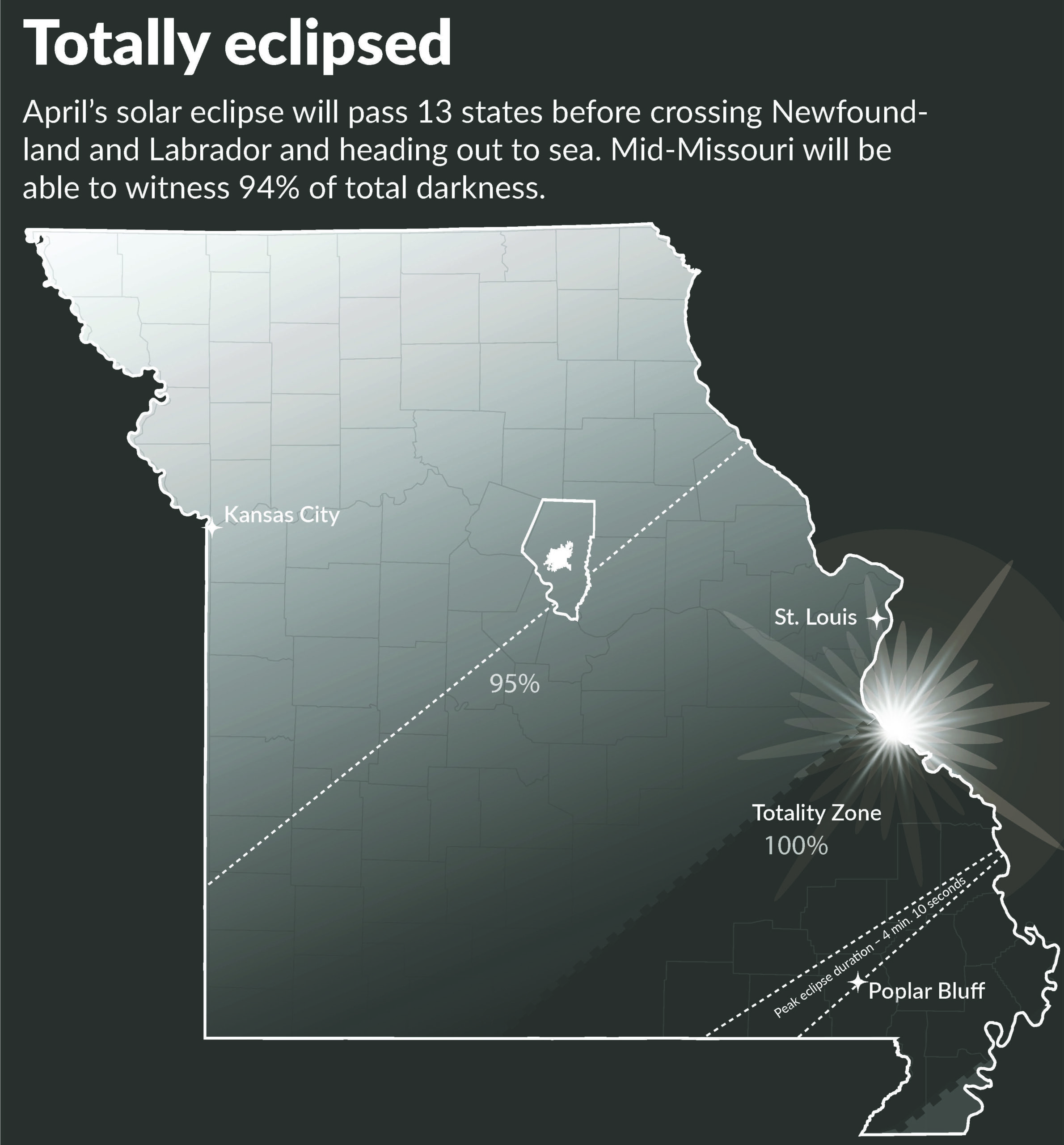By: Josh Stotler, Columbia Missourian
When a much-awaited solar eclipse moves across the country on April 8, mid-Missouri will be able to witness more than 94% of total darkness.
The path of the eclipse will move from Mexico north through Texas and southeast Missouri to the eastern provinces of Canada.
It will pass 13 states before crossing Newfoundland and Labrador and heading out to sea. The stretch of totality is expected to measure 115 miles wide across the United States and cover an area inhabited by about 31.6 million Americans.
Because the path is just below Columbia, the closest places to witness totality will be counties south of St. Louis and Jefferson City into the Bootheel.
St. Louis will see 99% totality, while the cities of Poplar Bluff, Ste. Genevieve, Cape Girardeau, Perryville, Kennett and Sikeston will see total darkness.
Poplar Bluff is already putting together a citywide watch party, and Missouri’s state parks have begun taking reservations for campsites in the path of totality.

Photo by Teddy Maiorca
The eclipse will last 4 minutes, 28 seconds, plunging a swath of North America into darkness. It will last twice as long as the total solar eclipse that captivated us in 2017.
In Columbia, the moon will start to move across the sun at 12:40 p.m., reach maximum darkness at 1:57 p.m. and exit at 3:14 p.m. At 2 p.m., the sun will become a thin crescent above the city.
The MU Astronomy Department is planning to stage an event on Lowry Mall on April 8 with eclipse glasses and other gear.
Because the 2024 eclipse is longer than the one in 2017, Columbia will have a better chance to notice the atmospheric and visual effects of the eclipse, said Val Germann, a 40-year-member of the Central Missouri Astronomical Society, who volunteers with the Laws Observatory.

That means observers will feel a temperature drop and see corona activity or outer atmosphere of the sun, which is normally harder to see because of the sun’s brightness.
“I think this is a very good opportunity,” said Yicheng Guo, an associate professor at the Department of Physics and Astronomy at MU. “Waiting for the next several years is way different from waiting for the next 100 years.”
After this one, the United States won’t see another total eclipse until 2044, when it will follow a path across the American Northwest. Another eclipse in 2045 will bisect the country with a sliver hitting the southwest corner of Missouri. After that, it will be 100 years before another one is nearby.
Parks taking campsite reservations for the April 8 eclipse are Sam A. Baker State Park in Patterson; Echo Bluff State Park in Eminence; Hawn State Park in Ste. Genevieve; Johnson’s Shut In’s State Park in Middle Brook; Lake Wappapello State Park in Williamsville; St. Joe State Park in Park Hills; and Trail of Tears State Park in Jackson.
Towosahgy State Historic Site in East Prairie is planning a special event for the eclipse, as is Missouri Mines State Historic Site in Park Hills.
A party in Poplar Bluff
NASA has listed Poplar Bluff as one of the best places to see the eclipse, and the city has been preparing for the event for more than 18 months.
“We’re very excited and thankful,” said Morgan McIntosh, director of downtown development and membership services with the Poplar Bluff Chamber of Commerce.
“Really looking forward to what this is going to do for our locally owned businesses and the economic impact it’s going to have.”
The city, with a population of around 18,000, is expected to see between 20,000 to 25,000 visitors during the April 5-8 eclipse weekend.
“We have people coming in from all over the world,” McIntosh said. “We’ve had phone calls from Japan, we have a family of 15 coming from California who travels the world to watch these, and they picked Poplar Bluff.”
Called “Total Eclipse of the Bluff,” the party will feature fireworks, a performance by comedian Jeff Foxworthy and a music festival with the band, Night Ranger.
Other weekend events include a 50/50 raffle, night golf on Friday, a free music festival Saturday, and former NASA astronaut Col. Tom Akers speaking at Three Rivers Community College on April 8.
Akers, who grew up in Eminence, said he plans to show photographs of his experience in space.
“It’s just a pretty cool experience,” he said. “I think it makes people think about how our solar system and things you don’t normally think about day to day.”
Lunar eclipse in September
Five months after the solar eclipse, Columbia will be able to see a partial lunar eclipse. This is alignment where the earth passes between the sun and the moon and casts a shadow on a portion of the moon’s surface.
The Sept. 17-18 lunar eclipse will be seen in North and South America, Europe, most of Asia, Africa, Pacific islands, the Indian Ocean, the Arctic and Antarctica.
Solar eclipses and lunar eclipses are actually not that rare, Guo said. On average, two solar eclipses and two lunar eclipses can be seen somewhere on Earth every year.
This year will also have four supermoons when a full moon is within 90% of its closest point to Earth. Supermoon dates are Aug. 19, Sept. 18, Oct. 17 and Nov. 15.
Wonky April weather
According to the National Weather Service in St. Louis, April it is the rainiest month of the year, with an average precipitation of 4.88 inches.
The National Weather Service in St. Louis is already predicting that April 8 will experience “above normal temperatures” and “normal precipitation,” with the normal high registering at 66ºF and the normal low at 44ºF.
“If the weather’s bad, I’m going to stay home, too,” Germann said. “If the whole Midwest is clouded out, we’re just sunk.”
But if it’s sunny, he said, make plans to head somewhere to witness a total eclipse.
“You will not believe it,” he said. “You will not regret it. It is absolutely unbelievable.”








Facebook Comments